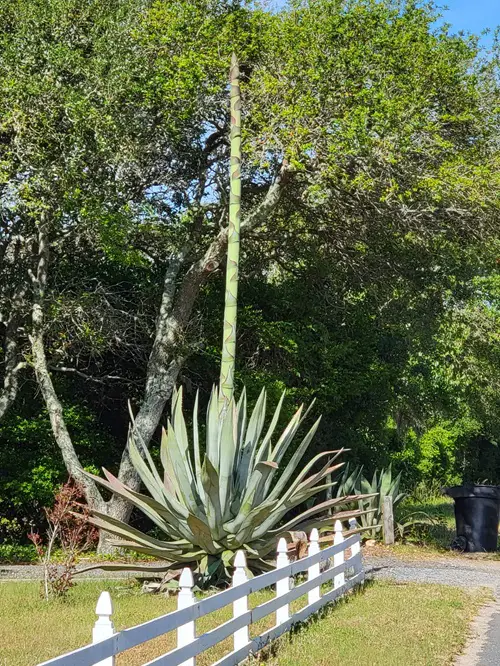Aren’t you excited to meet these plants that look like cactus? Read along and the fourth one on the list is interesting!
If you are curious enough then, it might excite you that many plants look like cacti or are sometimes called cacti but are not actual ones! If you know what this is about and want to know the rest of the story, here is a list of plants that look like cactus.
Plants that Look Like Cactus
1. Euphorbia
Botanical Name: Euphorbia species
While talking about Euphorbia, it is important to note that this genus holds a huge number of diverse species. These are succulents that are very easy to grow and maintain and are best for beginners! Unlike some typical succulents, this plant genus comes in amazing shapes, sizes, and colors.
This group of plants can resemble the appearance of cacti because of their distinct spines, lesser leaves showing on the spiny stems, and so on. Some of them showcase bright colorful stems whereas some bear beautiful flowers.
Caution: Be careful while handling them, because most Euphorbia species have toxic sap that is poisonous to humans and pets.
2. Pachypodium
Botanical Name: Pachypodium species
Pachypodiums are from Madagascar and South Africa with no real common names, rather are known as spiny succulents with thick trunks that store water to utilize it in drought conditions. These succulents also bear flowers in pastel shades of red, yellow, pink, and white depending on the species.
Due to its spines all over the trunk, this succulent is most often misidentified as a cactus! Even you might be wondering why this isn’t a cactus. However, the elliptical leaves with a midrib ranging from 3-6 inches in length make it different from a cactus.
3. Agave
Botanical Name: Agave
Here is one unusual desert beauty that holds about 200 species in the genus Agave. This group contains some economically important species especially those used for making mescal liquor and extracting fiber. These plants feature a rosette pattern of succulent or leathery leaves in green, dark green to gray colors.
Agaves are often popular as the ‘Century plant’ that looks like cacti because of their pointy and hard foliage, some even bear spines at the edges of their leaves. Also, since both cacti and Agave thrive in the desert so, it can sometimes be confusing to identify them.
4. Aloe
Botanical Name: Aloe
Yes, Aloe is on the list as well! This popular plant is commonly misnamed “Cacti”, because of its spines and cactus-like growing nature in arid environments. So, this is why the listicle is made for you! Most people have used its gel-like pulp that is stored inside its thick leaves to heal a cut or burn.
Aloe is naturally available in the dry regions of Africa, Asia, Europe, and the USA. However, because of its popularity and economic importance, there are only a few regions that do not cultivate this plant. Many lotions, soaps, and cosmetic products contain Aloe gel.
5. Stapeliad

Botanical Name: Stapeliad
If you are a fan of unusual-looking flowers, you shouldn’t be missing out on this! This plant is truly special for its eye-catching blossoms in red and creamy hues that are again topped with a glossy or rubbery texture. Besides, its succulent, angular, green stems are laterally flat with rows of warts along each edge, which make this plant look like a cactus.
Still, it is a different Southern African native that has many people fooled by its succulent stems. These plants are sometimes referred to as the Star of David as the flowers resemble a Jewish star. If you’re around this plant when it’s flowering you’ll notice that it gives off an unpleasant odor that still attracts flies for pollination.
6. Ocotillo

Botanical Name: Fouquieria splendens
Ocotillo is the most common name of the genus Fouquieria. Native to the Southwest United States and Mexico, it grows along with cacti in the harsh desert regions and even in areas that are too hot and dry for cacti.
This one is confused with cacti because of where it grows and for its distinct thorns on the upright stems. Ocotillo may or may not have leaves at any given time throughout the year. Moreover, it can shed and re-grow leaves as many as seven times in one year!
7. Ice Plants
Botanical Name: Lampranthus species
Another African native, the genus Lampranthus consists of many species that are mostly used as ground cover in warmer climates. These plants feature succulent leaves and bright, Gerbera-like flowers. Ironically the Ice plant’s stems most closely resemble the cactus species Rhipsalis, which exhibits the least exciting, relatively smallest flowers of the Cactus family.
Some species of this genus occur in Cape Flats Sand Fynbos, which was once common but is now seriously threatened due to habitat loss from human encroachment and alien plant invasion. It has apparently been reduced to two populations, both of which are small and fragmented.
Well, coming to the end of this listicle, please let us know which one is your favorite. If your heart can make a choice among these beauties, share it with us too!












